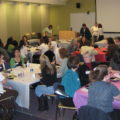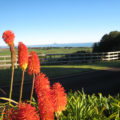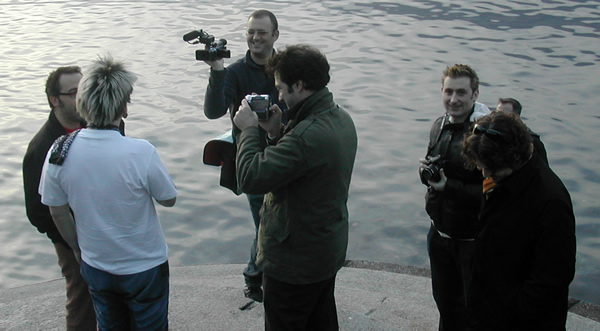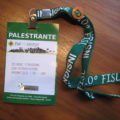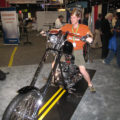Note: This was listed in the catalog as “Social Media: If You Liked it, Then You Should Have Put a Digg on It…”, which I wouldn’t have bothered to attend, but when I walked by the room the title had changed to “Social Media: Connecting with Customers”, which was a lot more obviously interesting to me. This was also one of the few panels that didn’t seem to treat large corporations (and those of us who work for them) as the enemy.
Panel:
- Chris Bowler – VP Social Media Lead, Razorfish (moderator)
- Jordan Corredera -Â Director of Online Marketing, Carnival Cruise Lines
- Paula Drum – VP Digital Marketing, H&R Block
- Malini Ratnam – Digital Media Mgr, Avenue A/Razorfish/JCPenney
First, each panelist gave an overview on what their company is doing in social media (comments on the companies themselves are partly my own, for the benefit of non-US readers who may not be familiar with these companies):
H&R Block
Well-known in the US as a tax preparation service, H&R Block’s problem is that their business is extremely seasonal, running from January (they kick off their advertising season with the SuperBowl) through Tax Day on April 15th. They are trying to use social media to stay in the public consciousness year-round. The overall theme is customer connections to build lifelong relationships.
Tactics include:
- a tax news widget for tax professionals
- YouTube contests
- online community
- tax-themed content related to other times of year, e.g. back to school, company benefits enrollment periods
- provide customer service via Twitter and Yahoo Answers
- helping tax professionals participate in these programs as well
- along with the Social Media Club, have organized/participated in Tweetups in 10 cities
JC Penney
Penney is a very old retail company, and is trying to overcome a rather musty reputation with younger shoppers: “Trying not to be ‘your mother’s store’.” They have chosen to actively participate in women’s online communities.
Their first big project is the extremely funny “doghouse” video (which I had seen long before this conference, though I had probably forgotten that it was done by JC Penney):
At the time it had had 4.1 million views with a 60% completion rate, resulting in 600 (new) Twitter followers and 1100 tweets/retweets. It was initially seeded from a Penney microsite using Facebook Connect. Traffic crashed the server and led to higher fees. Offloaded the traffic to YouTube.
They’ve also set up a Facebook group targeted to women, after finding that segmentation by Penney sub-brands did not work. And they’ve got a customer service Twitter account.
Someone asked what was the ROI on the doghouse video campaign. The answer was that brand awareness, not ROI, was the objective; a hard sell would not have been as successful.
Carnival Cruise Lines
In 2005, Carnival set up a group planning tool built on Community Server. The Cruise Talk forum there grew to 500 posts/day, and was followed by a “scrapblog” and a Twitter account with 1300 followers.
Then came a blog by John Heald, a cruise director, which has become immensely popular, as measured by 100 comments a day [visitor stats were not given].This has grown into a multimedia extravaganza including live chats, videos (quality was an issue), etc. Cruising is inherently social, so this has worked well.
[D here: This is an example of how effective social media marketing can be when tied to a real personality. You can also build community around that person: Heald fans want to talk to each other, there are now even Heald-themed fan cruises.]
Then the moderator asked questions:
How do you set up your organization to participate in social media?
H&R Block: You have to figure out where does this fit. Customer service, communications, marketing, field coordination…? The company isn’t yet on board, we’re still in a skunkworks phase. We’re trading off media dollars with human capital – we have only one person for Twitter, which is a 24/7 job. [But she said later that some resources are being shifted to social media.]
Also, the Federal Trade Commission is changing the legislation about blogging [as relates to professional tax preparers]. We’re still figuring out how to train people, what legal disclosures are needed. Ideally, we’d like tax preparers to be blogging. Education and support are difficult. People need to understand that it’s okay to have your own personality.
JC Penney: Similar situation, we have no dedicated social media team. [Some problem of] brick and mortar stores vs. jcpenney.com. Facebook took off for us when it became a two-way conversation, but that takes dedicated staff.
Carnival: We have an online community manager with two moderators and a social media strategist. Not seeing any particular efficiences from online yet.
How can we measure the results of social media?
Page views, links to transactions.
How does this tie back to brand? How do we make the brand relevant to the new generation?
Word of mouth as brand tracker, but it moves over multiple years.
ROI = Risk of Ignoring
creating spheres of influence, measuring awareness
Traditional ROI isn’t the be-all and end-all – Twitter is free! [except for staff time]
Use Radiant6 to monitor buzz.
Facebook charges $300k for a brand page – Carnival elected not to spend this. Buying a YouTube channel can cost $500k plus media costs.
But you can get started for free.
If you’re going to lead social media [teams], you have to be doing it yourself.
Content creation is expensive.
How might employee culture affect the use of social media in older companies?
An interesting question, but, frustratingly, I didn’t note the answers. Maybe there weren’t any.
D’s Conclusions
A good and useful session, one of the few at SxSWi to address the needs of large companies and their employees.
I was very frustrated that Sun was not speaking on this panel, as we have one hell of a story to tell in this space.
And, even absent Sun’s support infrastructure for blogs, wikis, and video, I could have told them that there are cheaper ways to do this stuff than what Facebook and YouTube are charging for branded offerings.

